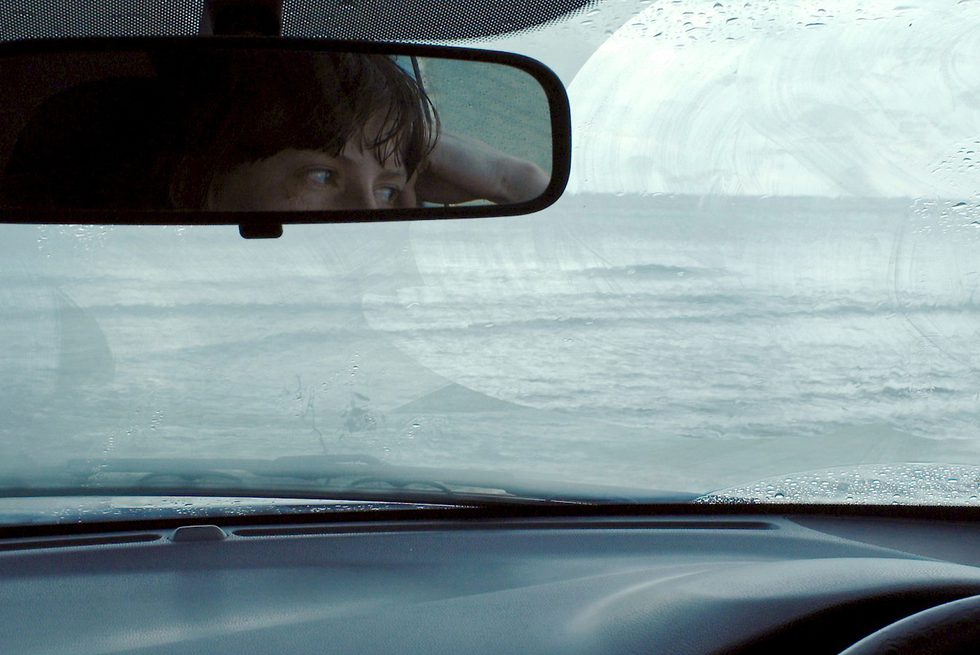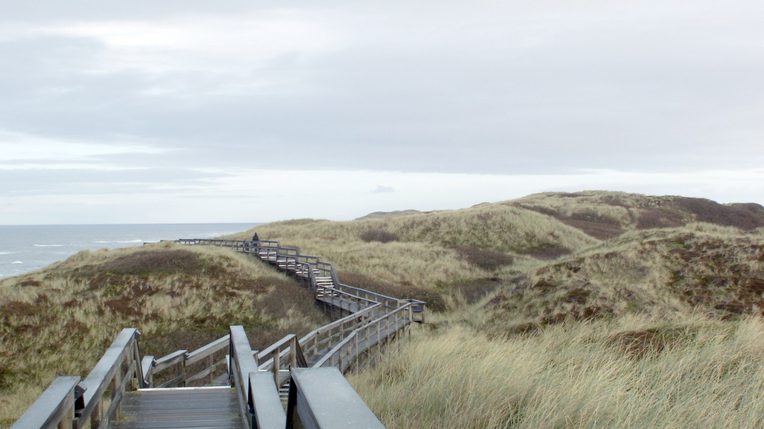
Imagine a giant crocodile is paddling in the primeval ocean, back and forth, circling around, constantly mixing the mud with the water. Everything is in motion. Then one day, a man arrives, a mythical warrior and kills the crocodile so it can’t paddle any longer. And slowly the sand settles to the ground and densifies. This creates land and sea. And that’s why the world is the way it is today.
This anecdote of a creation story, which we are told is from Papua New Guinea, comes about ten minutes into Drift (2017), a film centered around two women and the sea. We never return to the story again. More provocation than explanation, this myth of the world’s prehistory points to the unfortunate and chance separation between land and sea.
Shot, directed, and edited by Helena Wittman and conceived in collaboration with anthropologist Theresa George (who also appears in the film as a fictional researcher-traveler with the same name), Drift is a meditation on friendship and on the movements and meanings of the sea. Unscripted and loosely organized around a journey and separation, it starts and ends on solid ground (Antigua, first, and then the Azores). The film’s middle portion casts its viewer out to sea, adrift on the North Atlantic. Day becomes night becomes day. Time and space become unanchored, as does thought.

Though it is narratively loose and concerns itself with the affections and textures of drifting—asleep, away, across the Atlantic—Drift adheres to a stable and even rigorous style of shooting. On land, carefully composed static shots and long takes allow us to take in objects and people in motion, grounding us in distinct places (a hotel room, a beach, a seawall) and in time (one character, Josephina, is moving back to Argentina in a few weeks). When we follow Theresa out to sea, images come loose. Seawater fills the frame. Objects and people no longer function as anchoring points for perspective. At times, the film denies us even the horizon, that most essential aspect in landscape photography. It is only when the image comes undone, unmoored from the stability land provides, that the formal qualities of water become apparent. In watery frame after watery frame, the ocean becomes a composite of movement, color, light, and sound. The variations are endless, it seems, and absolutely absorbing. These more aqueous and immersive moments owe much to Drift’s sound design, created by Nika Breithaupt, which skillfully mixes field recordings with original electronic compositions. The film’s sound allows us to appreciate the physics of water: force, direction, and state.
In his article “Nature/Culture/Seawater,” Stefan Helmreich (2011, 133) describes anthropology’s recent theoretical turn to “the form of water,” charting a history of how the field has approached water in thought: as protean, unbounded nature distinct from land; as a substance subject to material and historical formations; and, more recently, as a “theory machine” (Helmreich 2011, 132) for describing and understanding processes of globalization and political economy. Drift certainly opens up opportunities to approach the sea on any and all of these levels. But it does more than this. It asks us to observe and appreciate water as a living force and a mutable element. This is one of the values that film and audiovisual media can contribute to ethnographic work. It can help us think with the most common elements of our world by holding them up to the senses. In Drift, we see and hear water in various states and at different scales: contained in a drinking glass, pooling at the bottom of a shower, falling as snow, dispersed as fog and foam. In capturing the variety of forms that water takes, the film poses the ocean as a particular object and substance to think and feel with, casting it as a fluid expanse for thought and affection.

What Wittman and her collaborators have created can be compared to an equally watery film like Leviathan (2012), which explores the impacts of industrial fishing and the ocean as a sensory environment. It would be simplistic, though, to associate Drift with a style of filmmaking loosely known as “sensory ethnography” and be done with it. Prompted by the film’s closing reference to Michael Snow’s Wavelength (1967), an iconic example of 1960s American experimental cinema, I was reminded of how the best citations are more than formal exercises. When done thoughtfully, they call up associations as a means to reorganize memory and understanding. I can’t say I know exactly why Wavelength takes the name it does, or why it ends on a photograph of the open ocean as opposed to anything else, but seeing a moment from this 1967 film cited in Drift expanded my appreciation for both. It also opened up other potential angles on waves as metaphor and concept (in physics, musical composition, optics, and so on).
To say that Drift is a film about water as element would be inaccurate. Other sequences—snippets of conversation between Theresa and her friend Josephina; their movements across the city; their time vacationing, working, and in their own homes—anchor its more fluid explorations. In opposition to a sense of drifting, indirection, and formlessness, we feel the gravity (and gravitas) of certain pulls: the moon on tides, or the affections and bonds between people. At one point, Josephina promises to send Theresa a message in a bottle, an absurd and quaint proposition given our contemporary moment of instant communication and technology’s promise to overcome the old inconveniences of time and distance.
In one scene, Theresa crouches on a sandy shore, selecting some rocks and shells and turning them over in her hands. Drift, too, feels like a collection of audiovisual tokens chosen from land and sea and assembled for us to regard. It is, among other things, a film that teaches its viewers how to observe and listen to the world, how to sit with images as if with a friend. In its quiet way, it shows how we might form intimacies with a watery world and across oceans.
References
Helmreich, Stefan. 2011. “Nature/Culture/Seawater.” American Anthropologist 113, no. 1: 132–44.